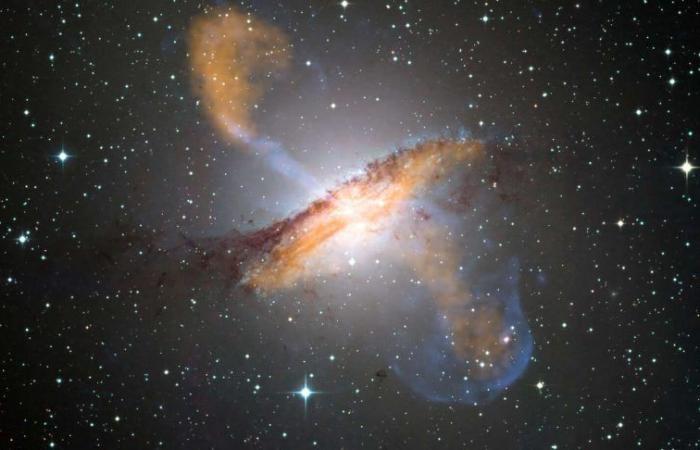A CERN press release recently announced that the physicistsphysicists and engineers members of the Fireball collaboration had succeeded in reproducing on Earth the plasma formed from jets of charged particles produced by Kerr black holes rotating behind the active nuclei of galaxies. These were not jets produced by mini black holes just synthesized by proton collisions at the LHC as we hoped to produce almost 20 years ago. It was a question of mimicking some of the processes around the supermassive black holessupermassive black holesor not, accreting matter and which are at the origin of the jets observed for a long time by the astrophysicistsastrophysicistslike those of the galaxygalaxy Centaurus A (also called NGCNGC 5128 and Caldwell 77), a lenticular galaxylenticular galaxy located in the constellationconstellation of the Centaur, or even Messier 87Messier 87.
Fireball members generated and studied these jets, which are thought to be made ofelectronselectrons and their antiparticlesantiparticlesTHE positronspositronsusing Cern’s HiRadMat facility, which uses high-speed proton beams energyenergy accelerated by the Super Proton Synchrotron for this purpose.
HiRadMat (High-Radiation to Materials) is a major European facility for materials testing established ten years ago. It can deliver high-intensity pulsed beams, with high momentum, to an irradiation zone where accelerator components, high-power targets and various other material samples can be tested. To obtain a fairly accurate French translation, click on the white rectangle at the bottom right. English subtitles should then appear. Then click on the nut to the right of the rectangle, then on “Subtitles” and finally on “Automatically translate”. Choose “French”. © INFN Multimedia Group, Cern (text)
Particle production predicted by quantum electrodynamics
More precisely, the physicist Charles Arrowsmith and his colleagues took advantage of a process already described theoretically in 1934 by Hans Bethe and Walter Heitler. In the present case, similar calculations in the framework of quantum electrodynamics à la Feynman show that by passing close to nuclei in a target in graphitegraphite and in tantalumtantalumhigh energy protons are slowed down by the field electrostaticelectrostatic of these nuclei and consequently emit photonsphotons gamma.
Still thanks to the presence of this field, the sufficiently energetic gamma photons are then transformed into pairs of electrons and positrons. This kind of process occurs not only with black holes accreting matter, but also with pulsars or with cosmic rayscosmic rays colliding with the nuclei of the high atmosphereatmosphere on Earth, generating a cascade of similar iterated processes and ultimately leading to showers of secondary particles on the ground (Oppenheimer contributed to the description of the formation of these showers).
In the Cern press release accompanying a publication in Nature Communications of an article that can be found in open access on arXiv, Charles Arrowsmith explains that the interest of the experiment carried out by Fireball is that “ electron-positron plasmas are believed to play a fundamental role in jets astrophysicsastrophysicsbut the computer simulationscomputer simulations of these plasmas and these jets have never been tested in the laboratory. Laboratory experiments are essential to validate the simulations, because certain simplifications of the calculations, which appear reasonable, can considerably alter the conclusions. “.
Did you know ?
Remember that it was the American astronomer Heber Curtis who first noticed in 1918 a curious elongated structure in a photograph of the galaxy Messier 87, taken with the Lick Observatory telescope. He could not have known at the time that he was in the presence of a jet of material extending at least 5,000 light years away from the black hole M87*, containing 6.5 billion solar masses at its core. of M87, an elliptical galaxy located 55 million light years from the Milky Way.
As early as 1964, the great Russian astrophysicists Yakov Zel’dovich and Igor Novikov, independently and at the same time as their colleague Edwin Salpeter in the United States (Hubert Reeves’ thesis director), had proposed that quasars and more generally nuclei active galaxies, or supermassive black holes accreting matter; in 1971, Donald Lynden-Bell and Martin Rees even proposed one in the heart of the Milky Way. We have every reason to believe that this is indeed the case, especially since the discoveries of the members of the collaboration Event Horizon Telescope which, with an Earth-scale network of radio telescopes, produced images showing the shadow of the event horizon of the rotating black holes M87* and Sgr A*.
In the case of M87*, we use it as a laboratory to test our ideas on rotating Kerr black holes, the accretion disks with which they surround themselves, the electrodynamic and magnetohydrodynamic phenomena of plasmas at the origin of the emission of jets of relativistic particles in particular. These are keys to understanding quasars and their roles in the evolution of galaxies.
His colleague Gianluca Gregori, co-author of the article, adds that “ The primary objective of these experiments is to reproduce in the laboratory the microphysics of astrophysical phenomena such as jets emitted by black holes and neutron starsneutron stars. Our knowledge of these phenomena comes almost exclusively from astronomical observations and computer simulations; only, the telescopestelescopes cannot really examine the physicalphysical on a microscopic scale and simulations are based on approximations. Laboratory experiments like this help link the two methods “.
The Cern press release concludes with the declarations of Alice Goillot, responsible for operations at the installation: “ Fireball experiences are one of the latest additions to HiRadMat’s range of experiences. We look forward to continuing to reproduce these rare phenomena thanks to the unique properties of the Cern accelerator complex “.
In the meantime, for those who would like to know more about hole jets, here is a repeat of some explanations that Futura had already given in a previous article.
A black hole transformed into a magnetic dynamo
As for the theory now mostly accepted to explain the formation of black hole jets, its discovery was made in 1977 by two young relativistic astrophysicists then at the University of Cambridge, Roger Blandford and Roman Znajek. Roger Penrose had already shown at the end of the 1960s that it was possible to extract energy by slowing down the rotation of a black hole and therefore by drawing on its kinetic rotational energy. The two researchers then constructed a scenario more elaborate than that of Penrose, but based on the same idea.
Roger Blandford talks to us about supermassive black holes and their jets in this video. To obtain a fairly accurate French translation, click on the white rectangle at the bottom right. English subtitles should then appear. Then click on the nut to the right of the rectangle, then on “Subtitles” and finally on “Automatically translate”. Choose “French”. © Quanta Magazine
It is this process – called Blandford-Znajek – which will be necessary to explain not only the brightnessbrightness of the quasarsquasars but the existence of jets of matter often associated and which can be detected for example when they produce two radio sources at the ends of these jets when they collide with the intergalactic medium.
Until recently it was supported largely only by simulations digitaldigital and analytical calculations. But, as explained in a long article published by Quanta Magazinethe famous and renowned digital periodical of the Simons Foundation which covers the latest developments in physics, mathematics, biology and computer science, this situation is about to be revolutionized by the observations of theEvent Horizon Telescope with M87*M87*.
The instrument provided images and measurements, especially at the polarization level of the lightlight issued by the accretion diskaccretion disk around the supermassive black hole which are in line with the predictions of the Blandford-Znajek process, more precisely of one of the two main accretion scenarios studied at thecomputercomputer for a while. Surprisingly, it is not the one that appeared the most credible that is today tested and favored by the EHT data.
Let’s see what it’s all about. When matter forms an accretion disk, it spirals toward the attracting body, rotating faster the closer it gets. It is initially in the form of a gasgasbut this gas is viscous, which means that due to the differences in speedspeed between two concentric rings of material in the disk there will be friction forces which will heat the gas.
The disk of matter around a black hole will therefore ionize, electric currentselectric currents and magnetic fieldsmagnetic fields will be born in the plasma formed. There is a whole theory of these phenomena in space-timespace-time curve. Blandford and Znajek used it to describe what was happening due to the properties of Kerr’s space-time metric, as the experts say in their jargon.
Around the spherical horizon of the black hole then exists a zone in the shape of an ellipsoid of rotation called the ergosphere. A radially free-falling body will be forced to have an additional rotational component upon entering this region. This is also true for the magnetic field lines generated by the disk, so that everything ultimately happens as if we had a magnetmagnet in rotation and the equivalent of a dynamodynamo producing potential differences.
Two essential consequences arise from this. First of all, these differences will accelerate charged particles almost to the speed of lightspeed of light and finally, the rotation of the black hole will twist the magnetic field lines and some will form a sort of twisted tube following the axis of rotation of the black hole and along which the charged particles will rise. Clearly, these are the jets of supermassive black holes, these particles then starting to radiate intensely, which will produce pairs of particles-antiparticles which are themselves accelerated and which will in turn radiate, in agreement with the process of Bethe-Heitler and so on.






